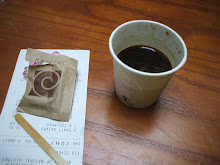Perhaps the most interesting and informative seminar I attended at last week's Craft Brewers Conference was on draft-line management. The basic message came down to this: most of you are drinking beer that doesn't taste as it should. There are a variety of reasons for this, but you can be reasonably assured that the draft beer we're drinking at most bars and restaurants in the States is not being served the way the brewer intended. Whether the beer is too old, under-carbonated, or poured through bad lines, finding a place that will do its best to avoid the problems isn't easy.
Old beer comes in a few varieties. An old IPA will begin to lose its hops. Other beers begin to taste like cardboard or paper. This happens because most beers are made to be tasted fresh, as I've commented on in other posts. Most beers — even the yellow fizzy ones — are a fine-tuned balance of hops and malt. As they age, the balance changes. In most cases, this is not a desirable change, and it often happens because a distributor or retailer has simply held onto a keg or bottles for too long. You can also find the change in bottled beer. Over the past week, I heard more than a few tales of brewery owners who found beer that was past its prime in a store and bought it — just to keep the bottles from changing someone's opinion of the beer. More's the pity that an awful lot of distributors, bars and restaurants may not go to the same trouble.
Under-carbonated beer is an even more common phenomenon. Think of that sports bar where they pour a beer full to the rim of the pint glass. The beer is under-carbonated. I guarantee it. Beer should naturally have a head unless it's a low-carbonated barrel- or bottle-conditioned beer. The primary criminal in these cases is the gas used to pump the beer. Check the row of taps at the sports bar (or wherever you got that beer that had no head and lost what fizz it had) and you'll probably see a stout tap. Stouts are generally poured with a mix of nitrogen and carbon dioxide, producing that low-carbonated, velvety texture you associate with the style. Unfortunately, a lot of bars and restaurants run the same gas through their entire run of taps rather than separating the nitro taps from the CO2 taps. Test a bottled beer against the same beer poured off these taps, and you'll see the difference.
You could perform a comparable test between a bottled beer and one poured off dirty lines. If a bar or restaurant does not clean its draft lines, the lines begin to build up a residue. The residue will begin to add off-flavors like butter, sour or green apple to a beer. Likewise, if the restaurant doesn't cover its taps between closing and opening, bacteria and wild yeasts can collect in the taps and create some pretty funky flavors. This can also cause the infamous foaming taps, the ones you see making bartenders work to pour full beers without a glass full of foam. I recently asked a local pub how often they cleaned their lines. Mind you, this is a place that should know better. The bartender shrugged and said it was maybe every few months. The answer explained every complaint I'd heard about their beer.
To people in the brewing business, this isn't earth-shattering breaking news. My guess is that it remains a dirty little secret that bars and restaurants foist on the rest of us, though. After all, why would they want you to know that their cost-saving measures mean the product you drink isn't what the brewer intended?
skip to main |
skip to sidebar

I'm back. Have a blast, y'all.

About Me
Blog Archive
- June (1)
- July (1)
- May (5)
- January (3)
- December (1)
- November (2)
- September (4)
- August (11)
- July (7)
- June (1)
- May (2)
- April (2)
- March (5)
- February (4)
- January (4)
- November (3)
- October (3)
- September (3)
- August (1)
- July (3)
- April (2)
- March (5)
- February (3)
- January (7)
- December (8)
- November (12)
- October (5)
- September (8)
- August (6)
- July (5)
- June (14)
- May (13)
- April (24)
- March (21)
- February (22)
- January (22)
- December (20)
- November (26)
- October (24)
- September (35)
- August (27)
- July (36)
- June (21)
- May (26)
- April (28)
- March (27)
- February (20)
- January (38)
- December (26)
- November (11)
- October (32)
- September (33)
- August (30)
- July (36)
- June (34)
- May (50)
- April (36)
- March (3)
- January (3)
- December (3)
- November (3)
- August (6)
- July (4)
What I Like
- A List Apart
- Accidental Creative
- AdLand
- AdRants
- Atrios
- Batocchio
- Byrd House Market
- Chowhound
- Creating Passionate Users
- daddytypes.com
- Daily Kos
- Design Observer
- design*sponge
- Epicuriousity (John Haddad)
- Flickr shots
- Gawker
- Getting Real - 37 Signals
- Gothamist
- Incertus
- Phil's bookmarks (web design and more)
- river city food and wine
- Smeltery fonts
- TreeHugger
- Veer
- Vitaly Friedman's fonts
- Wonkette
- Wornamental, Thornamental Design
- Xtcian
- zefrank
